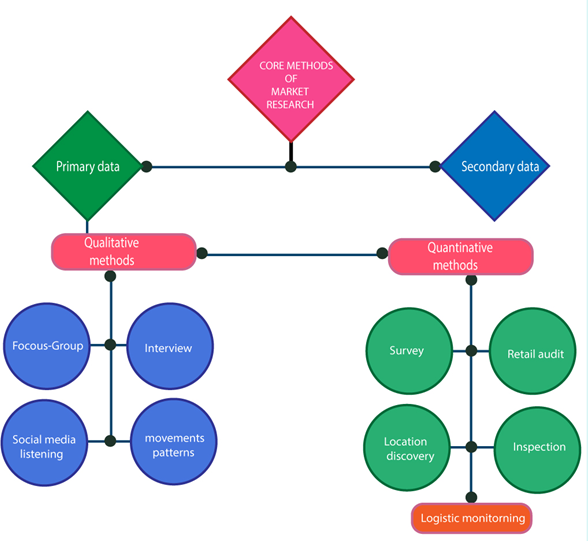What are the different methods in quantitative and qualitative methods? Explain when to use which research method
In-Brief
- Sample Qualitative data analysis plan uncovers the potential strategic directions for branding or communications programs
- Data analysis plan for qualitative research helps to develop parameters to relevant questions, range of responsesfor a quantitative study
- Statistical data analysis in qualitative market research help in identifying the customer needs by developing a hypothesis for testing the outcome of the questionaries.
Introduction
Quantitative data analysis in business research assist you in collecting, interpreting and analyzing data, quantitative research deals with numbers and Statistical data analysis, while qualitative research deals with words and meanings in the outcome. Both are important to get different kinds of knowledge in the study engaged.
Quantitative research methods
Quantitative research methods expressed in numbers and graphs. That are used to test or confirm theory and assumptions. These research are used to establish generalizable facts about the research topic. The quantitative research method requires many respondents to carry out the research. The most common method of Quantitative research includes experiments and observation recorded as numbers, a survey with a closed-ended query.
- Surveys:
The survey research method is a quantitative method to collect information from a group of respondents by asking multiple survey questions about your product and service.In business,the research survey method is Primary data collection used to test concepts, reflect attitudes of people towards your brand, establish the level of customer satisfaction. It is the list of multiple-choice questions distributed to a sample. Mostly the survey takes place through online, in person or over a phone call.
- Experiments:
The experimental research method is a method conducted with a scientific approach using two sets of variables. The first set variable acts as a constant, which you can use to measure the differences of the second set. It is a scientific method in which one or two independent variables manipulated and applied. These variables are controlled and operated continuously to establish cause and effect of the relationship.
- Observations:
The observation research method is a quantitative technique where researchers observe the participants ongoing behaviour in the normal situation. It depends on the type of observation research on the goal of the study. Market research qualitative data analysis will have different levels of participants in the study. The psychologist and other social scientists commonly use Naturalistic observation. It involves observing and studying the spontaneous behaviour of the participants.

Qualitative research
The qualitative research method is the method commonly expressed in words, to understand the concepts, thoughts and experience in research. These types of research enable the researchers to gather in-depth insight on the topic that is daunting.Analysis and Interpretation of Qualitative Data in Consumer research includes an interview with the open-ended question, observation described in words, and the literature review that explores the theories and concepts.
- Interviews:
An interview is a qualitative research method that involves asking an open-ended question to the respondent and collect elicit data about the subject. The interview is the process conducted to a particular population, and the critical characteristic exhibit is their conversational tone. Interviews are most effective for qualitative research because they help you to explain, better understand, and explore research area opinions, behaviour, experiences, phenomenon, etc.
- Focus groups:
The focus group is the standard qualitative research method used in the business for marketing purposes. Qualitative data analysis dissertation helps youbrings 6-10 people together in a room to provide feedback regarding a product, service, concept, or business campaign.A trained mediator leads a 30-90-minute discussion within the group to gather helpful information to improvise the product or service.
- Ethnography:
It is the research where it observes and interacts with the study’s participants in the real-life environment. It is the process of participating in an organization for an extended period to observe culture and behaviour closely.
- Literature review:
The literature review is neither a qualitative nor quantitative research method, but a review of related works in the field of study which can fall under qualitative design. Literature review mainly conducted to evaluate the knowledge state on a particular research area. The researcher can use it to create research agendas, identify research gaps, or for debating about a specific matter.
When to use qualitative and quantitative research
Qualitative data analysis services use the thumb rule to decide whether to use qualitative or quantitative data.
Coding in qualitative research analysis usesQuantitative researchif you want to confirm or test something like a theory or hypothesis in your research. When your research needs to quantify behaviour, opinions, attitudes, use these variables to make the generalized decision. Quantitative analysis uses quantifiable data to articulate facts and reveal patterns in researchengaged.
The use of Qualitative researchif you want to understand concepts, thoughts, experiences. It is used for new product idea generation and development, primarily used in the study where there is a need to develop a hypothesis for testing. It helps to generate ideas, for improvement and extension of the product, line, brand.
Conclusion
Qualitative business s demographic and customer groups. The purpose of the parts is to determine the perception of the research and analysis helpsin exploring market segments that are important to your business, such acompany, brand, category and the product.
References
- Milena, Z. R., Dainora, G., & Alin, S. (2008). Qualitative research methods: A comparison between focus-group and in-depth interview. Annals of the University of Oradea, Economic Science Series, 17(4), 1279-1283.
- Queirós, A., Faria, D., & Almeida, F. (2017). Strengths and limitations of qualitative and quantitative research methods. European Journal of Education Studies.
- Frels, R. K., & Onwuegbuzie, A. J. (2013). Administering quantitative instruments with qualitative interviews: A mixed research approach. Journal of Counseling& Development, 91(2), 184-194.
- Moore, N. (2006). How to do research: a practical guide to designing and managing research projects. Facet publishing.



 Previous Post
Previous Post Next Post
Next Post